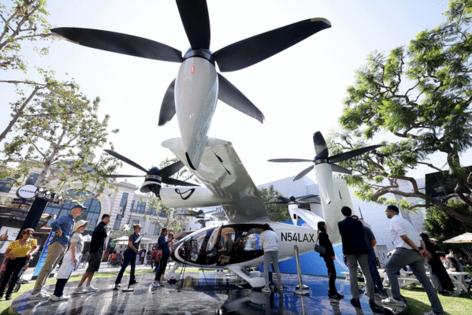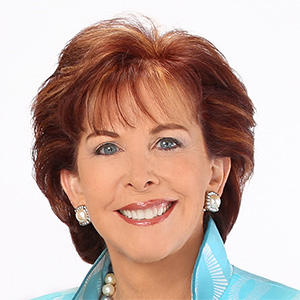Aviation startup seeks to bring air taxis to Los Angeles in time for Olympics
Published in Business News
Among storefronts and bustling customers at the Grove shopping mall in Los Angeles, a sleek black-and-white aircraft sat motionless on a podium.
Shoppers turned their heads as they passed by to get a better look, some using their phones to take photos. The all-electric aircraft could revolutionize city transportation and offer an escape from L.A. traffic, according to Joby Aviation, the company behind the contraption.
Joby is one player in a burgeoning industry that's trying to make flying cars a reality by bringing electric aircraft into cities and integrating them into transportation systems such as Uber. The aircraft blend technology from airplanes and helicopters and are capable of taking off and landing vertically.
Those working to bring the air taxis to market say they are significantly quieter than a traditional helicopter, offer more safety features and produce zero emissions. Joby says the technology will save customers significant travel time, especially in sprawling cities plagued by gridlock such as Los Angeles.
"It's a revolutionary type of aircraft that is both quiet and efficient and can solve the problem of how to make air travel at a small scale something you can do all the time," Joby Chief Product Officer Eric Allison said.
Joby's all-day public event at the Grove gave community members a chance to see the aircraft, sit inside and ask questions about the technology, he said.
Santa Cruz-based Joby was founded by Chief Executive JoeBen Bevirt in 2009, around the time Tesla released the Roadster, its first all-electric car. Archer Aviation entered the scene in 2018 in Santa Clara, Calif., and has plans to commercially launch its air taxis as soon as next year.
This month, the first all-electric airplane to be certified by the Federal Aviation Administration arrived at the Santa Monica airport, according to its builder, Eco-Aviation Foundation International.
Joby's air taxis, powered by six propellers and four battery packs, aren't quite ready to start flying customers over congested freeways. While Joby is testing prototypes of its aircraft in California, the company has completed only three out of five stages of the FAA certification process.
Joby will need approval from the FAA to operate commercially in Los Angeles or anywhere in the country. It hopes to launch the taxis in L.A. in time for the 2028 Olympics, Allison said. The taxis would be held to the same traffic and regulatory standards as other small aircraft.
"We will have commercially rated pilots flying these aircraft and they will operate in the airspace under exactly the same rules that everyone else operates under," Allison said in an interview.
Joby is creating its own training curriculum for pilots to fly its aircraft, which can travel up to 200 miles an hour at an altitude of up to 10,000 feet. The aircraft holds four passengers and a pilot and has a simple design inside.
The model aircraft at the Grove featured four tan seats with carlike seatbelts and plenty of legroom. Alison said the aircraft is particularly safe because it has built-in redundancies made possible by electric technology, including multiple motors, batteries and propellers.
Joby's goal is to make shorter-distance air travel accessible and convenient for everyday city dwellers, Allison said. The company expects to launch its air taxis at a price point similar to Uber Black, he said, but has the long-term goal of driving prices down to a level comparable to Uber X.
An Uber Black ride from downtown Los Angeles to Los Angeles International Airport costs about $100, although prices vary depending on time of day and demand. An Uber X for the same trip costs around $60.
Most trips in a Joby air taxi will require multiple legs, Allison said. After a customer uses an app such as Uber to schedule a ride through the skies, a car will come pick them up and take them to the nearest launching pad.
At the end of the flight, another car will transport the customer from the landing site to the final destination. The air taxis can use existing helicopter infrastructure for takeoff and landing, Allison said, but at least some helipads will need to be enabled with electric charging to power the taxis.
Joby is also working on building takeoff and landing infrastructure at American airports through a partnership with Delta Air Lines.
Outside the U.S., Joby applied in September to become a certified electric air taxi operator in the United Arab Emirates.
©2024 Los Angeles Times. Visit at latimes.com. Distributed by Tribune Content Agency, LLC.












Comments